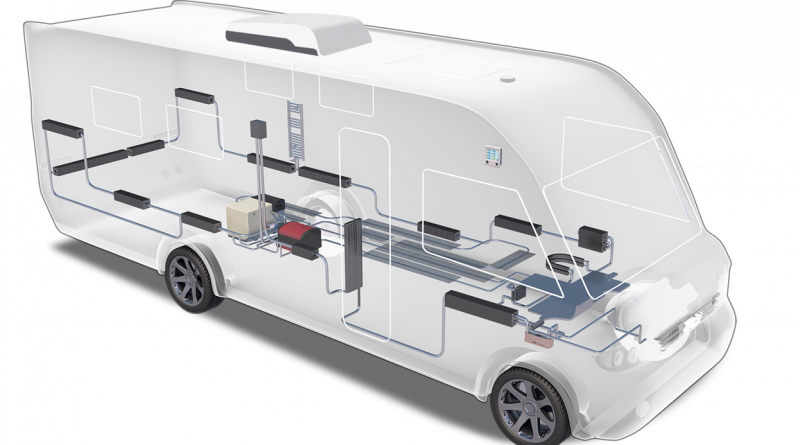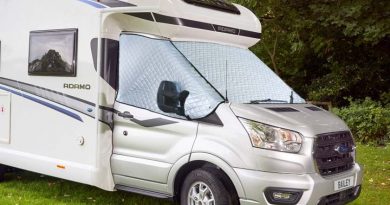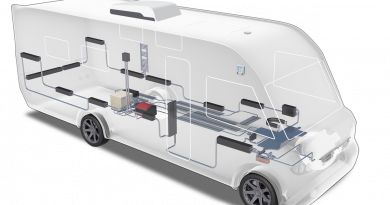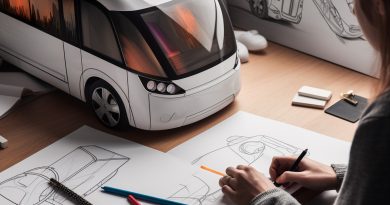Alde Heating Explained
Alde heating is a wet water heating system for recreational vehicles be it a motorhome or a caravan. It’s a quiet form of heating system as the laws of nature mean that the heated air circulates on its own. The convectors heat up air which rises upwards. When the warm air reaches the ceiling, it circulates downwards and inwards towards the floor and is reheated by the convectors. The circulating air heats furniture and walls as well as forming a cold barrier in front of the windows. An all-enveloping heat and natural air flow which produces an even heat distribution throughout the vehicle.
The Boiler
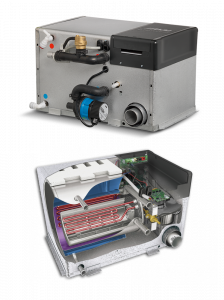 The Alde 320HE boiler produces heat for heating and hot water. To heat up the glycol fluid (the fluid that circulates round the heating system), energy from liquid petroleum gas or electricity is required. In the boiler, there is a liquid petroleum gas fired burner that works in two power steps, depending on how much heat is needed. If the caravan in connected to 230 V (120 V in US), you can choose electrical heating using the inbuilt immersion heaters in the boiler.
The Alde 320HE boiler produces heat for heating and hot water. To heat up the glycol fluid (the fluid that circulates round the heating system), energy from liquid petroleum gas or electricity is required. In the boiler, there is a liquid petroleum gas fired burner that works in two power steps, depending on how much heat is needed. If the caravan in connected to 230 V (120 V in US), you can choose electrical heating using the inbuilt immersion heaters in the boiler.
If you need extra heating, you can run on liquid petroleum gas and electricity at the same time, to obtain as rapid heating as possible. If you want the boiler to prioritise electricity for heating ahead of liquid petroleum gas, you can select this easily from the control panel. You can also select the opposite, and have liquid petroleum gas as the prioritised form of energy.
In order for the heated glycol fluid to circulate in the system, a circulation pump is required. Usually, it is fitted immediately adjoining the boiler.
The boiler has an inbuilt water heater, which makes sure you always have hot water for the shower and the kitchenette as soon as the boiler is running. The water heater provides about 15 litres (4 gal) of ready-mixed 40 ºC (104 ºF) hot water. If you are a winter camper and do not want freshwater in the vehicle, you can still run the heating system.
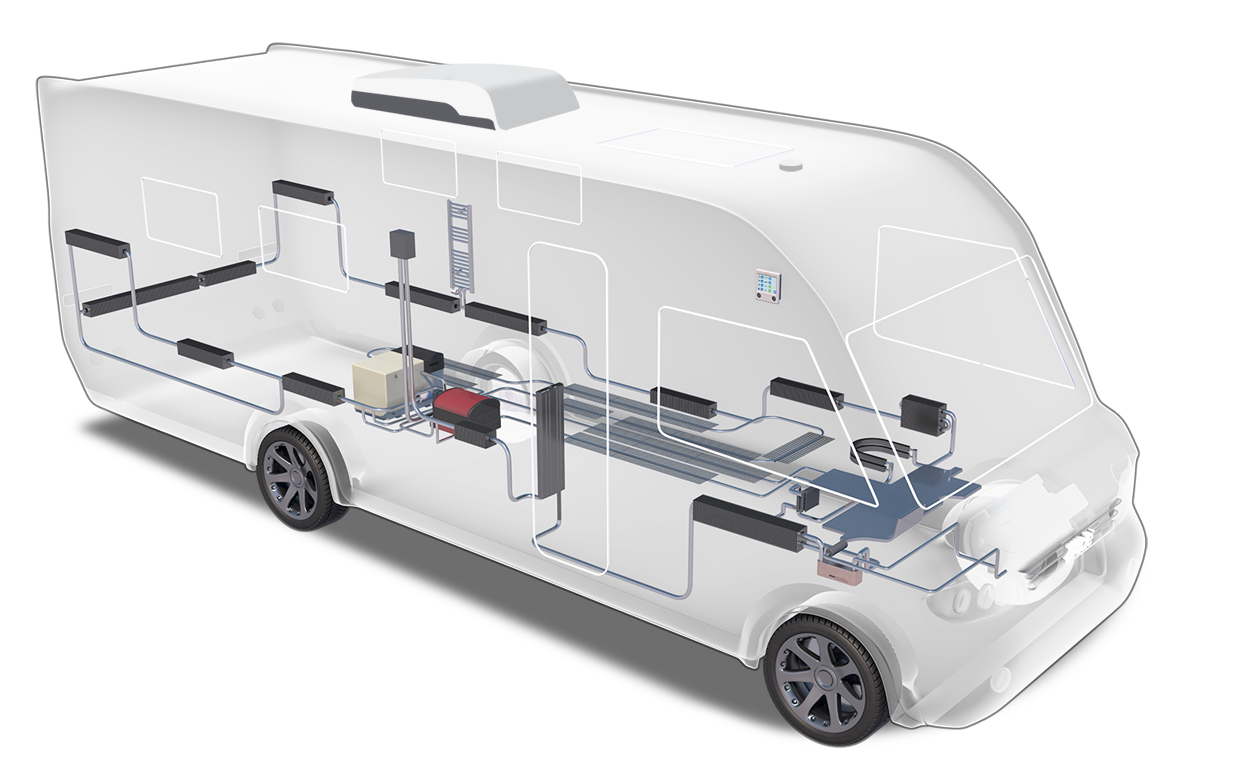
The Convectors (Radiators)
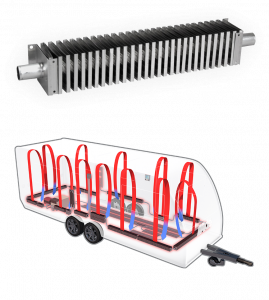 The radiators or convectors consist of heating pipes with densely packed aluminium plates. They are placed by the outer walls, usually hidden behind the furniture. The convectors emit heat that, via self-convection, surrounds you with a protective curtain of heat – an optimal solution that prevents draughts and downdraughts.
The radiators or convectors consist of heating pipes with densely packed aluminium plates. They are placed by the outer walls, usually hidden behind the furniture. The convectors emit heat that, via self-convection, surrounds you with a protective curtain of heat – an optimal solution that prevents draughts and downdraughts.
This is how self-convection works
In the Alde heating system, they make use of the fact that hot air naturally rises upwards, so-called self-convection. The convectors heat up the air, which rises and heats the walls and furniture as well as forming an air barrier between the windows to keep the cold out. When the warm air reaches the ceiling, it circulates down and inwards towards the floor and is reheated by the convectors. In this way you obtain gentle, quiet and efficient heating in the vehicle.
Convectors can also be placed with advantage in other spaces in the vehicle where extra, additional, heating is required such as, for example, behind the driver seats in mobile homes or in small insulated storage spaces, where there would otherwise be a risk for frost.
Underfloor Heating
 Alde underfloor heating with coils in the floor gives you a cosy, warm floor and that extra feeling of comfort. It consists of coiled pipes with heat-conducting plates which are milled into the floor. This gives you a complete heating system with a warm, comfortable floor on which to rest your feet. The coils are connected into the ordinary heating system and the heat flow is usually governed via shunt valves.
Alde underfloor heating with coils in the floor gives you a cosy, warm floor and that extra feeling of comfort. It consists of coiled pipes with heat-conducting plates which are milled into the floor. This gives you a complete heating system with a warm, comfortable floor on which to rest your feet. The coils are connected into the ordinary heating system and the heat flow is usually governed via shunt valves.
Underfloor heating is an excellent complement to the heating system’s convectors and contributes to rapid heating and even and comfortable warmth in the vehicle.
The Heat Exchanger
You can then save money, energy and the environment with the Alde heat exchanger. It utilises the motorhome engine’s cooling system for heating and production of hot water. It only works if you have a hydronic heating system.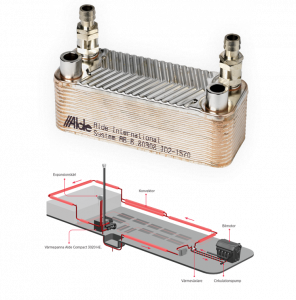
You can use your engine’s cooling system to heat the living area using a heat exchanger in combination with Alde’s hydronic central heating system. This will give you hot water as well, which is also heated by the motorhome’s engine. The only thing you need to do is to set the required temperature on the control panel, the system takes care of the rest automatically.
What this means is when you are driving en-route to your camp site the Alde Heating and hot water is being heated from the energy and heat of your vehicle engine, so you’re not using onboard gas or electric. When you arrive on site your vehicle will be pre-warmed and you’ll have hot water ready to go.
For winter campers, the heat flow can also be reversed together with a circulation pump on the engine side. The heat exchanger will then act as an engine heater, as the heating system will heat the engine’s cooling system.
The environmentally-friendly heat exchanger is one of the unique functions that you can only obtain with a hydronic heating system.
Control Panel
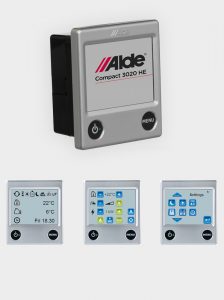 A simple and clear display enables you to control several smart functions and settings, automatic air conditioning and night mode for example. You can also use the control panel remotely via an app in your smartphone, which gives you full control of your heating system wherever you are.
A simple and clear display enables you to control several smart functions and settings, automatic air conditioning and night mode for example. You can also use the control panel remotely via an app in your smartphone, which gives you full control of your heating system wherever you are.
The control panel has a clear and user-friendly touchscreen with an intuitive and easy to navigate menu system, similar to the one on your smartphone. You can choose to control everything yourself, or have the automatic system do most of the work.
All key functions such as required temperature, extra hot water and energy selection are available directly on the start page. You also have the option here of making smart presettings, night mode for example, which mean that the temperature is automatically lowered to the required temperature at the time you have selected.
A tools menu is available if you want to make further adjustments or connect additional functions. You also control your accessories from here, underfloor heating and heat exchanger for the motorhome’s engine for example.
The control panel can also be used to control air conditioning* and thus obtain full automatic climate system in the vehicle.
The location of the control panel in the vehicle varies depending on manufacturer and model.

